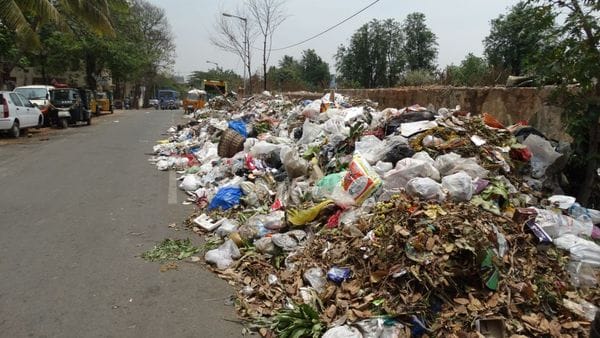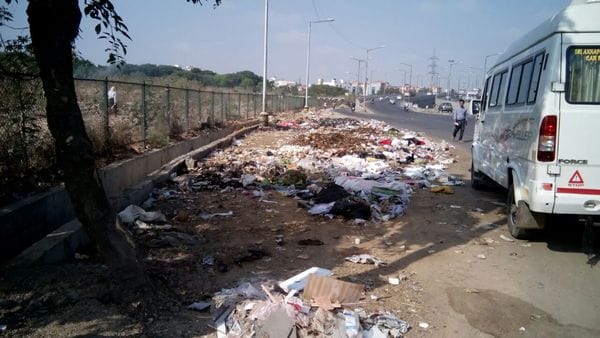
Nobody wants to take mixed waste, yet Bengaluru is sitting on quite a huge quantity of it. Pic: Shree D N
Heaps of unsegregated waste mixed with reject waste such as styrofoam plates and low value plastic lie unattended in the infamous backyard of Malleshwaram, that is 11th main. Some residents raised a hue and cry against Malleshwaram turning into a mini Mandur, even as the BBMP officials and contractors were figuring out how to handle the situation. This was the scene on 9th April, in Malleshwaram.
It has been little over three months since the BBMP announced strict penalty on citizens who don’t segregate waste. The decision to strictly impose penalty on bulk generators and individual houses was taken in the last week of December. Before this, BBMP’s Solid Waste Management Special Commissioner Subodh Yadav gave a press statement that the BBMP will not be collecting mixed waste.
Even earlier, in August 2013, the civic body had issued a circular and a public notice announcing penalty on those who violate the waste segregation rules. Karnataka Municipal Corporation Act, 1976 has provisions for a municipality to impose such fine.
There have been many more instances in the past when the BBMP has asked the citizens to segregate waste and impose fine for non-segregation. Segregation has been the theoretically accepted solution since the 2000s. The BMP distributed two bins to each house in the year 2000 and asked people to segregate. They also conducted surveys to measure the impact.
However, they could not impose penalty on residents. What’s stopping BBMP?
The secret behind non-collection of fine for non-segregation
How to collect the penalty from the citizens who refuse to pay – this has been the biggest problem troubling the health inspectors of various wards. The issue seems to be with the process of imposing penalty.
In Kadumalleshwara ward (ward 65), Junior Health Inspector Rahamathullah Khan tried issuing manual receipts to citizens violating the rule. In this system, the officer has to first issue the receipt and collect the amount from the offender. The officer has to then mandatorily remit the amount to BBMP account within 24 hours of issuing the receipt.
“This system does not work out well. Often, the citizens refuse to pay the penalty even after issuing the receipt. So, we, the officers end up paying it from our own pockets,” says Khan. After repetition of such instances where people refused to pay the penalty, health inspectors like Rahamathullah Khan have now stopped issuing penalty on violators.
Another way of imposing penalty is by making people pay through Demand Draft. This too has not been successful. When the system of manual receipts failed, some health inspectors changed the strategy. “After repeated incidents of people not paying us the amount and we ending up paying from our pockets, we shifted to the DD system. In this system, we orally direct the rule violator to come to the office with a DD (penalty amount). It is only after they submit the DD that we issue them the receipt. But, this system too has not been successful. People just don’t bother to come to us,” says Prathima, Junior Health Inspector at Attur ward.
“How many times can we remind them and or go behind them? Half of our time goes on this,” she adds.
Is penalty system designed to fail?
When Citizen Matters asked BBMP Solid Waste Management Special Commissioner Subodh Yadav on the effectiveness of penalty system, he said there are some issues which they are trying to overcome through IT-based solutions. “We are trying to implement electronic receipt issuing system, like how electricity bills are issued. It will be a centralised system, where all the records of penalty paid and unpaid can be tracked,” he said.
However, he agreed that there are some implementation challenges as well. “We do not have dedicated enforcement staff to impose penalty and go behind the offenders, unlike police department. Health and other officers have the responsibility of doing the office duty as well as enforcement duty. Therefore, it is not possible to expect the intensity in imposing penalty,” he opined.
He added that BBMP was not interested much in penalising people. “It is used as a last resort. Purpose is not to impose policing, but to bring behavioural change,” the Special Commissioner noted.
Mixed waste taken to processing units on alternate days
Amidst this, the BBMP has mandated that the compactors carry mixed waste from various wards to the processing plants not daily but on alternate days. For example, in Kadu Malleshwara ward in West Zone, waste is carried to MSGP Infrastructure plant located in Doddaballapur, on alternate days.
The result is what you see in the below picture, a mini Mandur-like situation.

A panoramic view of the mixed waste that was lying on 11th main, Malleshwaram. Pic: Shree D N
A BBMP official who did not wish to be named told this reporter: “Transporting mixed waste on alternate days works out only in an ideal situation. For example, if a ward produces 26-28 tons of waste every day, of the total waste, 12-14 tons is likely to be wet waste. In the remaining 12 tons, 7 tons could be dry waste and 5 tons could be reject waste. What is happening is that, waste is not segregated, hence a large quantity of mixed waste is piled up in the wards,” the official says.
A contractor who did not wish to be named explained how the plan is leading to problems not predicted by anyone. In some wards where citizens are vocal about piling up garbage, the contractors hire third party vehicles and take the waste out from the city. Though they claim that “farmers take it to their lands,” in reality nobody knows where it goes, but it goes out from the city. “What else are we supposed to do?” he asks.
There is also the problem of non-collection because of this plan. A compactor can hold 10 tonnes of wet waste, or 8-10 tonnes or even less of mixed waste. In a ward that has achieved 60% segregation like Kadu Malleshwara, 8-10 tonnes of mixed waste is left daily, which needs one compactor per day, while the provision is for one compactor per two days. This leads to the problem of pile ups in the ward, with 8-10 tonnes left in the ward every two days. If not tackled immediately, this will result in a garbage crisis yet again in the city.
Can segregation ever be successful?
HSR Layout has heaps of mixed garbage mounting in various parts. Kavitha Reddy, a volunteer of HaSiRuMitra in HSR Layout, says that 100% segregation at source is a myth, not a reality. “We need to build systems to process mixed waste too. Aim for 60% segregation, 40% mixed waste and build systems accordingly. Meanwhile promote segregation at source too,” she says.
She says that building systems for 100% segregation is a recipe for environment disaster, as the mixed waste will have no takers and will sit in the city itself, or will be thrown in farm lands or highway sides, causing a major problem.

A garbage dump on Outer Ring Road near BDA flyover in HSR layout. Garbage is always burnt here, but never cleared systematically. Pic: Kavita Reddy
However, the case of Chickmagalur proves that segregation at source is possible when the will power of the municipality to enforce it is strong.
Chikmagalur district administration introduced waste segregation in the year 2001. A team headed by Dr Shubha Vijay and Dr Geetha Venkatesh worked with the district administration to make it happen. Rahamathullah Khan, working as a Junior Health inspector for Kadu Malleshwara ward in Bengaluru currently, recalls the days he was working in Chikmagalur. The municipality distributed red and green bins to people and the waste was collected through push carts.
This is not all. Those days, the health inspector was authorised to inspect and report the garbage not given to municipality, not segregating waste etc. He had the right to ask people where they gave the garbage if there was no garbage from the house, and order the disconnection of electricity, water and sanitary connections when there was noncompliance.
Unlike in Bengaluru where the municipality collects Solid Waste Management cess through property tax, a monthly fee of Rs 30 is being levied per house for waste collection. The municipality used to collect Rs 4.6 lakh per month, just from the monthly fee then, which has gone up to Rs 11 lakh per month now.
How was it possible? Whenever the District Commissioners were supportive of the idea, the system worked fine. When the DCs hesitated to fine or penalise people, the system broke down, according to Dr Shubha Vijay. The system worked fine between 2001 to almost 2009.
A self help group by the name Dharmasthala Vividhoddesha Sahakara Sangha is now given the task of garbage collection. However segregation is not happening as it should. The secondary waste collection and disposal system for waste management is not good enough in Chikmagalur. Dr Shubha Vijay says her team, Swacch Charitable Trust, has started working again, to introduce secondary transportation and management systems in place.
ACT NOW!
Do you think the fine collection system should be improved? Please tweet to Chief Minister of Karnataka, BBMP Mayor and BBMP Commissioner, and have your say, now!
Note: Shree D N contributed to this story.
Related Articles
High court order on three-way segregation in Bengaluru
This segregation by colour will save us
Empowering the garbage collectors is the first step to segregation
Segregation at source is the key
How to segregate waste in apartments?
How to segregate waste in offices?
Understanding how to segregate waste
So you segregate waste, what happens next?